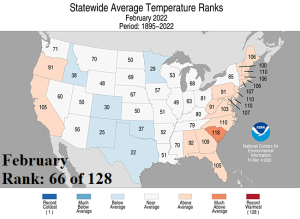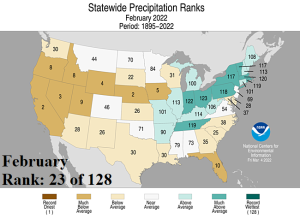High Impact Weather: Colder Ukraine, East Coast of Australia Heavy Rain Continues
03/02/2022, 10:35 am ESTGrowing Concern: Expansive Dry Pattern Developing in Europe
03/09/2022, 8:01 am EST



Fig. 1-4: The U.S. temperature and precipitation anomalies observed for winter 2021-22 versus the Climate Impact Company constructed analog forecast.
Discussion: The U.S. observed another warmer than normal meteorological winter (Fig. 1) while the national pattern was somewhat drier than normal (Fig. 2). The West Coast, South and Southeast U.S. were warmest compared to normal while the precipitation pattern was very dry in the central Great Plains to Texas while just to the east the Ohio and Tennessee Valley(s) were wetter than normal. The Climate Impact Company-constructed analog (CIC-CA) forecast issued last November was generally thematically correct indicating the warm pattern for winter although the Northwest forecast was too cold (Fig. 3). The precipitation outlook emphasized West Coast and Southeast U.S. dryness (Fig. 4) which was a little too dry and was not dry enough in the Great Plains.
The DEC/JAN/FEB 2021-22 state rankings for temperature averaged 19th warmest in the 128-year climatology. The warmest state ranking was in Georgia although 9 states averaged “much above” normal for meteorological winter including California and parts of the Mid-Atlantic States (Fig. 5). Northern tier states from Washington to Michigan averaged “near normal” for the winter season. There were no states with a colder than normal ranking.
The precipitation ranking for DEC/JAN/FEB 2021-22 was 13th driest on record. The driest states were Nebraska and Kansas plus Texas and Louisiana (Fig. 6). Wetter than normal climate rankings were confined to the Ohio Valley to Tennessee and North Dakota while Minnesota ranked “much above” normal precipitation.

Fig. 5: U.S. temperature state rankings based on 128-year climatology for DEC/JAN/FEB 2021-22.

Fig. 6: U.S. precipitation state rankings based on 128-year climatology for DEC/JAN/FEB 2021-22.
The final month of meteorological winter averaged near normal temperature nationally (Fig. 7). February observed a mix of marginal cold in the West-central/Central U.S. to milder than normal on the immediate West Coast and moderately warmer than normal on the East Coast with “much above” normal in South Carolina.
Another dry month nationally observed in February for the U.S. (Fig. 8) with a ranking of 23 (of 128 years). The driest states to finish the winter season were California and Nebraska each receiving their 2nd driest February on record. A total of 9 states were “much below” normal precipitation in February. The Ohio and Tennessee Valley(s) into the Northeast States were somewhat above normal precipitation for the final month of meteorological winter.

Fig. 7: U.S. temperature state rankings based on 128-year climatology for February 2022.

Fig. 8: U.S. precipitation state rankings based on 128-year climatology for February 2022.
